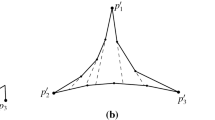Abstract
Given a set of point sites in a simple polygon, the geodesic farthest-point Voronoi diagram partitions the polygon into cells, at most one cell per site, such that every point in a cell has the same farthest site with respect to the geodesic metric. We present an \(O(n\log \log n+ m\log m)\)-time algorithm to compute the geodesic farthest-point Voronoi diagram of m point sites in a simple n-gon. This improves the previously best known algorithm by Aronov et al. (Discrete Comput Geom 9(3):217–255, 1993). In the case that all point sites are on the boundary of the simple polygon, we can compute the geodesic farthest-point Voronoi diagram in \(O((n+m) \log \log n)\) time.














Similar content being viewed by others
Notes
The paper [8] shows that their running time is \(O(n+m\log (n+m))\). But it is \(O(n+m\log m)\). To see this, observe that it is O(n) for \(m=O(n/\log n)\). Also, it is \(O(n+m\log m)\) for \(m=\Omega (n/\log n)\).
References
Aggarwal, A., Guibas, L.J., Saxe, J., Shor, P.W.: A linear-time algorithm for computing the Voronoi diagram of a convex polygon. Discrete Comput. Geom. 4(6), 591–604 (1989)
Ahn, H.-K., Barba, L., Bose, P., Carufel, J.-L., Korman, M., Oh, E.: A linear-time algorithm for the geodesic center of a simple polygon. Discrete Comput. Geom. 56(4), 836–859 (2016)
Aronov, B., Fortune, S., Wilfong, G.: The furthest-site geodesic Voronoi diagram. Discrete Comput. Geom. 9(3), 217–255 (1993)
Asano, T., Toussaint, G.: Computing the geodesic center of a simple polygon. Technical Report SOCS-85.32, McGill University (1985)
Chazelle, B.: A theorem on polygon cutting with applications. In: Proceedings of the 23rd Annual Symposium on Foundations of Computer Science (FOCS 1982), pp. 339–349 (1982)
Chazelle, B., Edelsbrunner, H., Grigni, M., Guibas, L., Hershberger, J., Sharir, M., Snoeyink, J.: Ray shooting in polygons using geodesic triangulations. Algorithmica 12(1), 54–68 (1994)
Guibas, L., Hershberger, J., Leven, D., Sharir, M., Tarjan, R.: Linear-time algorithms for visibility and shortest path problems inside triangulated simple polygons. Algorithmica 2(1), 209–233 (1987)
Guibas, L.J., Hershberger, J.: Optimal shortest path queries in a simple polygon. J. Comput. Syst. Sci. 39(2), 126–152 (1989)
Hershberger, J., Suri, S.: Matrix searching with the shortest-path metric. SIAM J. Comput. 26(6), 1612–1634 (1997)
Klein, R.: Concrete and Abstract Voronoi Diagrams. Springer, Berlin (1989)
Klein, R., Lingas, A.: Hamiltonian abstract Voronoi diagrams in linear time. In: Prooceedings of the 5th International Symposium on Algorithms and Computation (ISAAC 1994), pp. 11–19. Springer, Berlin (1994)
Mitchell, J.S.B.: Geometric shortest paths and network optimization. In: Handbook of Computational Geometry, pp. 633–701. Elsevier (2000)
Oh, E., Ahn, H.-K.: Voronoi diagrams for a moderate-sized point-set in a simple polygon. In: Proceedings of the 33rd International Symposium on Computational Geometry (SoCG 2017), vol. 77, pp. 52:1–52:15. Schloss Dagstuhl–Leibniz-Zentrum für Informatik (2017)
Oh, E., Barba, L., Ahn, H.-K.: The farthest-point geodesic Voronoi diagram of points on the boundary of a simple polygon. In: Proceedings of the 32nd International Symposium on Computational Geometry (SoCG 2016), vol. 51, pp. 56:1–56:15. Schloss Dagstuhl–Leibniz-Zentrum für Informatik (2016)
Papadopoulou, E.: \(k\)-pairs non-crossing shortest paths in a simple polygon. Int. J. Comput. Geom. Appl. 9(6), 533–552 (1999)
Pollack, R., Sharir, M., Rote, G.: Computing the geodesic center of a simple polygon. Discrete Comput. Geom. 4(6), 611–626 (1989)
Suri, S.: Computing geodesic furthest neighbors in simple polygons. J. Comput. Syst. Sci. 39(2), 220–235 (1989)
Toussaint, G.T.: An optimal algorithm for computing the relative convex hull of a set of points in a polygon. In: Proceeding of EURASIP-86, Part 2, pp. 853–856 (1986)
Acknowledgements
Funding was provided by Ministry of Science and ICT (KR) (Grant No. IITP-2017-0-00905).
Author information
Authors and Affiliations
Corresponding author
Additional information
Publisher's Note
Springer Nature remains neutral with regard to jurisdictional claims in published maps and institutional affiliations.
This work was supported by the NRF Grant 2011-0030044 (SRC-GAIA) funded by the government of Korea and the MSIT (Ministry of Science and ICT), Korea, under the SW Starlab support program (IITP-2017-0-00905) supervised by the IITP (Institute for Information & communications Technology Promotion).
Rights and permissions
About this article
Cite this article
Oh, E., Barba, L. & Ahn, HK. The Geodesic Farthest-Point Voronoi Diagram in a Simple Polygon. Algorithmica 82, 1434–1473 (2020). https://doi.org/10.1007/s00453-019-00651-z
Received:
Accepted:
Published:
Issue Date:
DOI: https://doi.org/10.1007/s00453-019-00651-z




